Silver buffalo berry is a large spreading shrub (0.5-3m tall) with brown branches covered with small bran-like scales and bright red berries. The leaves are elliptical shaped, opposite, and green with a felt of white and reddish-brown star-shaped hairs on the underside. It has thorny twigs and berry-like fruits that are sour, red, and soapy to touch. Indeed, silver buffalo berry is also known as soap berry. It is commonly found along open woods and along river edges in Canada.
Despite their appealing appearance, the fruits are bitter and contain saponin, a toxic compound that has a foamy quality in water. The berries should only ever be consumed in moderation; large amounts can cause severe gastrointestinal issues. Their bitterness is an acquired taste and so the berries are not commonly sought after. The berries are high in vitamin C and iron and are used as an emergency food by Indigenous peoples. The leaves and stems can be used medicinally to make a purgative medicine. It is also used as a wash for cuts, sores and to ease arthritis. The wood does not make good firewood, silver buffalo berry is also known as stinkwood.
